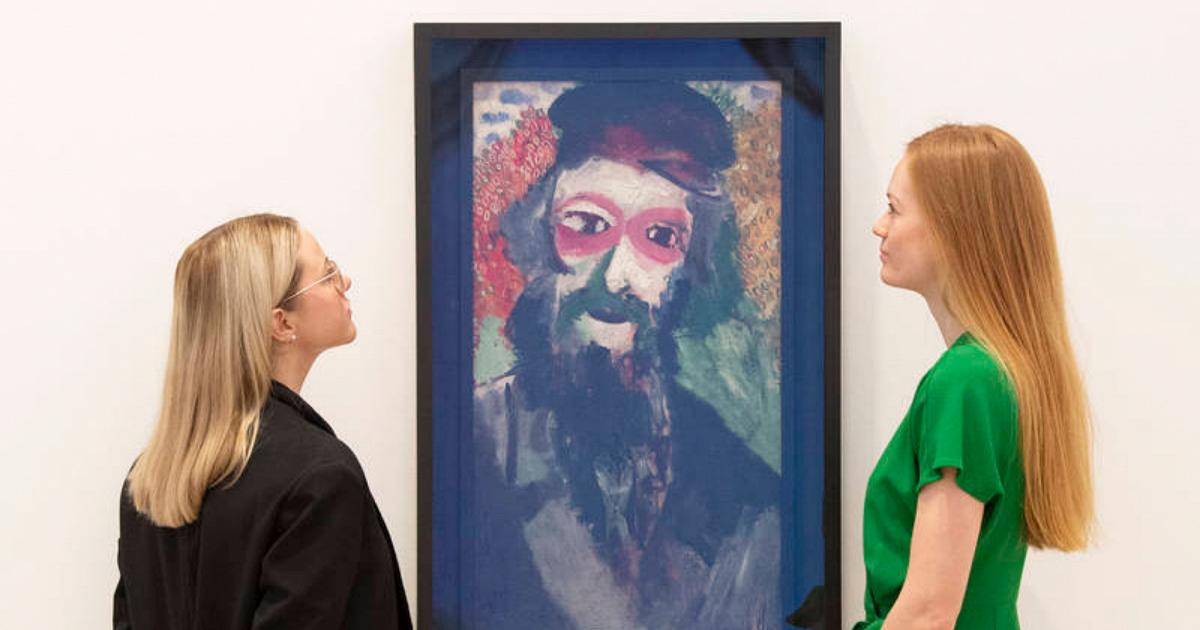Behind a picture there is a story, which in this case takes us back to the German raids during the Second World War.
This is the case of the painting by Marc Chagall, which was part of the 15 works stolen by the Nazis and finally returned by France to the heirs.
Going to auction, it was sold for $7.4 million at Phillips auction house in New York.
Chagall's 1911 oil on canvas, "The Father", was purchased in 1928 by a Polish Jewish luthier, David Cender, who lost everything when he was deported to Auschwitz, where his wife and daughter were killed, the luthier was saved but he could not get the painting back.
The work unexpectedly reappeared in some exhibitions and it was discovered that it was Marc Chagall himself who bought it.
It can now be admired at the Pompidou Center and deposited in the Museum of Jewish Art and History in Paris.
Siegfried Modola/Getty Images
Paris
Earlier this year, the French Parliament unanimously adopted a law for the restitution of 15 works of Jewish families looted by the Nazis.
Culture minister Roselyne Bachelot spoke of a historic "first step", as other looted works of art and books were still kept in public collections.
Germany
he is still in possession of thousands of works of art stolen across Europe, mostly from wealthy Jewish families.
Recently, the German Ministry of Finance quantified at 2,500 masterpieces not yet returned to their rightful owners which are currently located in state museums, ministries or in the federal deposit of works of art at Weissensee, in Berlin.
Another rediscovered masterpiece is the "Vase of Flowers" by Jan van Huysum;
here too there is a story made up of searches and returns home.
The eighteenth-century oil painting was taken from the Uffizi museum in Florence and was exhibited in the home of a German family.
After 75 years he returned to Palazzo Pitti, in Florence
.
To ask
Eike Schmidt,
director of the Uffizi Gallery in Florence.
The story emerged after Schmidt
,
of German nationality, had asked for its return.
The famous painting by the Flemish painter is back in Palazzo Pitti, in Florence,
in the exact place where the painting was, before being stolen by Nazi troops.
Ansa (EPA/CLEMENS BILAN)
Berlin, the Brandenburg Gate illuminated in the colors of the Ukrainian flag
pay
Jan van Huysum, Vase of Flowers, painting
Another painting, another story for the «Portrait of a young seated woman» by the French painter Thomas Couture, which belonged to a former French Interior Minister Georges Mandel, sentenced to life imprisonment for having collaborated with the Nazis by the collaborationist Vichy regime.
The work ended up in a collection of Cornelius Gurlitt.
Masterpieces were bought at bargain prices which is why the works ended up in private collections.
Then there was the collaboration of the Nazi leaders and in the case of the art dealer Gurlitt managed to have hundreds of masterpieces, including works by Max Liebermann, Chagall, Picasso, Otto Dix, Emil Nolde and Ernst Ludwig Kirchner.
Summing up we are talking about a collection of 1,200 works.
A "treasure" discovered by pure chance in 2012 during a tax inspection in an apartment
Munich and seized in 2013 the following year by the German authorities.
A major exhibition at the Martin Gropius Bau in Berlin
showed works from the
Gurlitt collection,
seized
by the authorities.
By itself, the Gurlitt collection has practically doubled the number of works of art stolen by the Germans, now in the possession of the German government.
handle
Jan van Huysum, Vase of Flowers, painting
Every raid, every work, from paintings to statues, recovered has been punctually annotated: in the inventory there are artists such as Chagall, Van Gogh, Nolde, Kandinsky and Munc.
There's more, because Goebbels, Minister of Propaganda during the Nazi regime, began a strict censorship on art in 1933, the artists who could work were only those who exalted Hitler's aesthetics.
Those who did not comply were placed in the artistic purge program: the works were confiscated, particularly from merchants and collectors of Jewish origin, they were sold to finance the government with some exceptions.
Between 1933 and 1945, the Nazis stole around 100,000 Jewish paintings, sculptures and other valuables from private collections in Europe.
In Rome the Italian investigators have,
pay
Hermann Goering, was one of 24 Nazi leaders tried for World War II war crimes in tribunals held in Nuremberg, Germany from October 18, 1945 to October 1, 1946. |
Location: Konigree, Germany.
The survivors who have faced a real odyssey are looking for their works.
This is the case with the true story of Maria Altmann, a Jewess of Austrian origin who fights to have
Gustav Klimt's painting, the "Portrait of Adele Bloch-Bauer"
, exhibited until then in the Belvedere Museum, and returned in 2006 to the descendants of the Jewish family and then bought by the entrepreneur Ronald Lauder for the collection of the New Gallery he founded in New York for a record sum of about 135 million dollars.
A story that became a
film "
Woman in Gold"
, with
Helen Mirren, Ryan Reynolds.
pay
Portrait of Adele Bloch-Bauer, Klimt
pay
Woman in Gold, poster
Another film based on true stories is
"
The Monuments Men", by George Clooney: a team of allies who during the war tried to find and save the works of art stolen and hidden by the Nazis in Germany.
pay
The Monumentsmen

